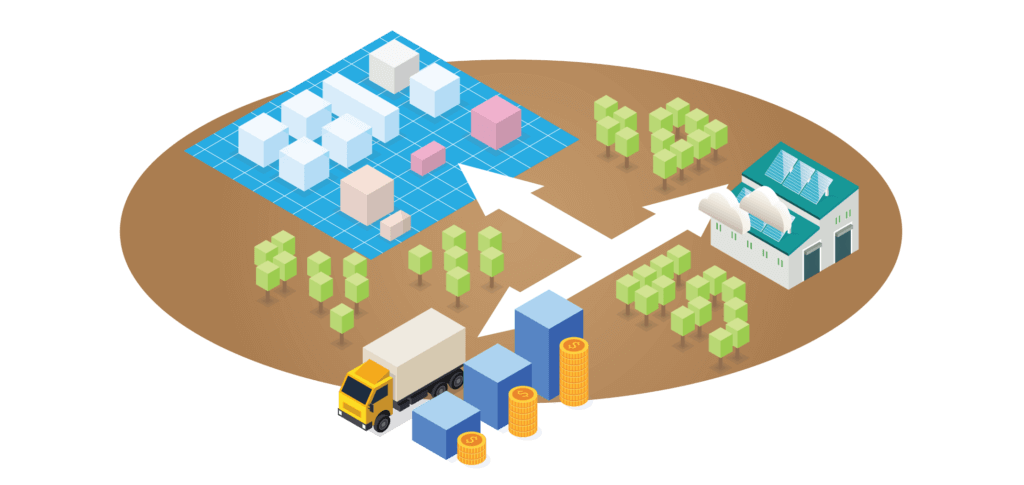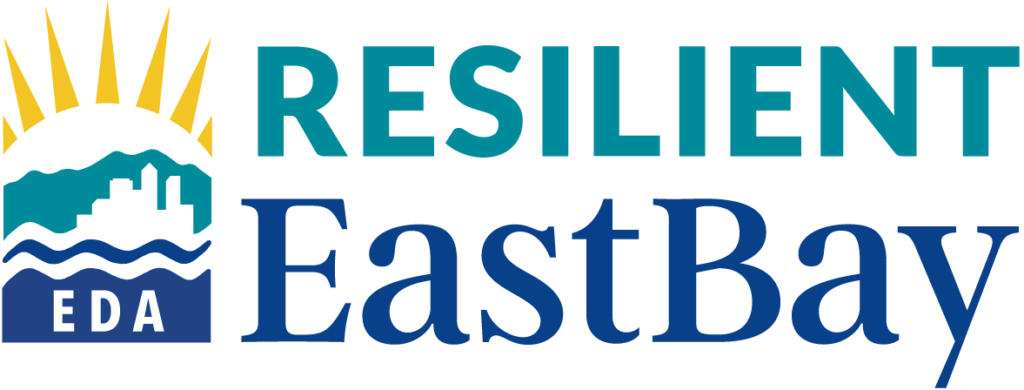- Protecting Economic ResiliEnce
Industrial
Lands
In order to retain its resilience as a region, the East Bay must prioritize the retention and development of its industrial lands. Industrial lands and the manufacturing jobs they support play an important role in inclusive economic development, by allowing a region to source its materials locally and retain its economic diversity.

Retaining and developing industrial land is essential to the East Bay’s robust, inclusive, and resilient economy. East Bay industrial land is home to a diverse group of industries that provide middle-wage jobs and innovative technology development and production. This land is also vital for greenhouse gas reduction strategies—enabling the East Bay to produce and transport goods more sustainably, source materials locally, and reduce shipment distances. This toolkit will help support industrial lands as an essential economic resource across the East Bay’s many diverse communities. The primary audience for this toolkit includes business leaders, cities, counties, regional agencies, and developers.
To help the region understand and navigate the challenges of supporting a diverse and resilient industrial economy, East Bay EDA and its partners have created an Industrial Market Insights report and Industrial Land Use Toolkit. These findings draw upon ten months of extensive research, including input from local and regional public agencies, brokers, and developers.
**If you are a company seeking industrial space for lease, please contact us.**
Industrial Market Insights
The East Bay Industrial Market Insights report provides an overview of employment and real estate market trends within four East Bay industries: Distribution & Logistics; Transportation; Manufacturing; and Life Science.
The report presents results for the East Bay as a whole, as well as six sub-regions, allowing local communities to understand how their part of the East Bay is functioning as a larger part of the regional ecosystem.
The report offers four key findings:
- The East Bay is an Industrial Ecosystem: East Bay cities have complementary assets and opportunities that can support all stages of the industrial life cycle.
- Building form is not the same as building function: one of the most highly-regulated building types, warehouse buildings, is also one of the most flexible, changing uses over time and playing host to a wide variety of industries.
- Relatedly, the East Bay’s industries are dynamic and always evolving: the region has shown the ability to reinvent itself time and time again in response to changing opportunities and economic demands. Flexible building types and zoning codes provide a platform for this continued evolution.
- Lastly, while the East Bay’s subregions each have different strengths and unique challenges, there are also many issues around which disparate communities have common ground; through collaborative efforts, all members of the East Bay community can enjoy improved industrial prospects.
Industrial Land Toolkit
Industrial Land Use Toolkit Purpose
The purpose of the Industrial Land Use Toolkit is to help East Bay cities, counties, economic development organizations, regional agencies, business service organizations, and real estate professionals to collaborate together to address their industrial challenges. Through improved zoning, planning, and collaboration, communities throughout the East Bay can streamline land use policies and provide programs to support ongoing economic innovation and business success for small and mid-sized businesses in the East Bay’s growth industries at all phases of the business cycle. This work focuses on the same growth industries that are central to the remainder of the Resilient East Bay project:Overview of Goals
This toolkit addresses four regional industrial land use goals:1. Support innovation in small & mid-sized firms across growth industries and all phases of the business cycle
Making sure that small businesses have the resources they need to get started, technology they need to stay competitive, and diverse business spaces and locations needed to accommodate production and distribution activities.
2. Facilitate industrial flexibility and evolution
Fostering land use policies, infrastructure investments, and economic development policies that encourage business flexibility, and allow East Bay industrial land and buildings to be used for different uses over time as economic circumstances change.
3. Help businesses stay in the East Bay
Promoting inter-jurisdictional cooperation and preservation of industrial land to enable businesses to find appropriate sites for expansion within the region, instead of exporting production activities to other regions.
4. Strengthen the East Bay as a regional ecosystem
Marketing the strengths and unique assets of each of the East Bay’s subregions for complementary economic activities. Promoting collaboration among city leaders, utilities, regional agencies, brokers, developers, businesses, and educational institutions to improve the industrial climate of the East Bay overall.
How to Use This Toolkit
The toolkit provides strategies, ideas, and recommendations for three different subject areas. We recommend starting with the subject area that is most relevant to you but reading all three sets of tools and recommendations to get a picture of how everyone works together to improve industrial land use in the East Bay.
1. Zoning and Project Approvals
- This section provides zoning code recommendations and project approval improvement suggestions to facilitate industrial land protection and new development.
- Primary Audience: City Leaders and Planning Staff
- Secondary Audience: Developers, Brokers, Economic Development Staff, and Business Leaders
2. Planning and Local Finance
- This section reviews district-based planning initiatives and other economic development support programs that can be used to encourage new industrial development and retention of industrial lands.
- Primary Audience: City Leaders, Economic Developers, and Planning Staff
- Secondary Audience: Developers, Brokers, and Business Leaders
3. Regional Ecosystem Collaboration
- This section provides recommendations for improved regional connections, investments, and planning efforts to encourage effective collaboration and long-term infrastructure planning.
- Primary Audience: City Leaders, Regional Planners, Economic Developers, and Utility Providers
- Secondary Audience: Developers, Brokers, City Planners, and Business Leaders.
Sources
Pendras, M., & Dierwechter, Y. (2022). The Metropolitan Production of “Urban” Sustainability: Exploring Industrial Regionalism Across the Puget Sound. Frontiers in Sustainable Cities
Wolf-Powers, L. (2005). Up-Zoning New York City’s Mixed-Use Neighborhoods. Journal of Planning Education and Research (24), p. 379-393.3
Chapple, K., et. al, 2017. CCI Industrial Land Study.
A full list of the working group participants can be found in the acknowledgments section of the website.


